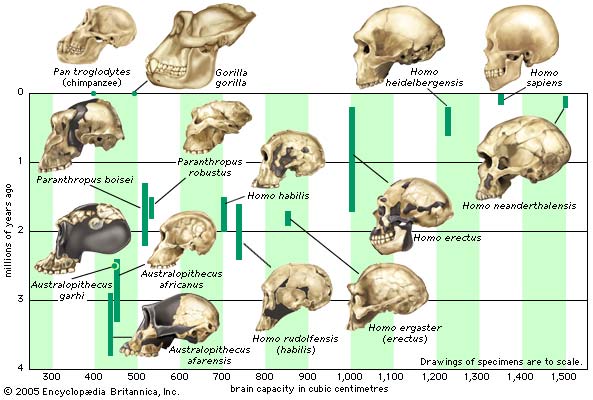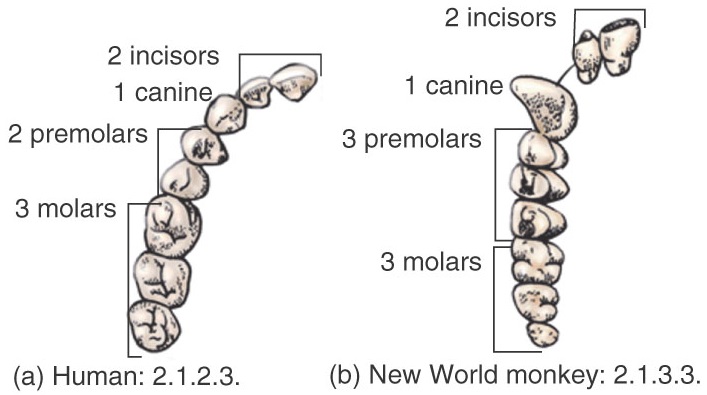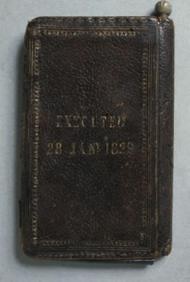Turkana Boy or Nariokotome Boy is the name that was given to the fairly recent find, 1993, of a nearly complete Homo erectus skeleton. This find was a stroke of luck by a team lead by Richard Leakey (I spoke of his father's, Louis Leakey, findings in this earlier blog: http://anthropologicalconcepts.weebly.com/blog/-the-paleoanthropological-goldmine-olduvai-gorge). But just how did they know it was a skeleton of a Homo erectus? H. erectus is seen at the first that left Africa 1.8millions years ago. Skulls of this species of Homo have been found in, of course, parts of Africa, parts of Europe, and parts of Asia; some were found on the islands of Indonesia. Since a skull is usually all the physical anthropologists have to work with when figuring out what species they have in their hands, I will discuss how the skull of Homo erectus differs from other skulls.
From the name of the species, Homo erectus, is illustrating that they walked up right. When a species is bipedal you can see it in the skull. With the bipedal evolution the inner bones of the ear have to be altered to keep balance when walking. The biggest difference has to be the spine which has to attach at a certain angle to the skull. For the Australopithecus afarensis species the foramen magnum (the opening in the base of the skull that receives the spinal cord) is further back, unlike the H. erectus and us, we have it in the center of our skull because the spine is now able to balance the head. Now, I am sure you are asking yourself “if they were bipedal how else can they be differed? Maybe they are H. sapiens skulls.” That is a good point, but the base of the skull is not usually looked at as definite evidence it belongs to a different species.
The actual shape of the skull of H. erectus is entirely different than that of a H. sapein (image below). You can see that it it has a football shape as opposed to the rounded skull of a H. sapiens. The H. erectus also has pronounced brow ridges and a lowered mandible. One difference that cannot be seen in photos is the thickness of it. “The braincase and the face and jaws of Homo erectus were very heavily built, with thick bones and extreme thickenings along some of the skull sutures (where two skull bones connect).” As for the entire skeleton that I mentioned at the beginning of my blog, aside from having a broad chest (image below), it is almost identical to that of modern humans. Not only that, but some scientists, using evidence from fossil crania, claim they may have been more like humans; such as having a growth spurt.
From the name of the species, Homo erectus, is illustrating that they walked up right. When a species is bipedal you can see it in the skull. With the bipedal evolution the inner bones of the ear have to be altered to keep balance when walking. The biggest difference has to be the spine which has to attach at a certain angle to the skull. For the Australopithecus afarensis species the foramen magnum (the opening in the base of the skull that receives the spinal cord) is further back, unlike the H. erectus and us, we have it in the center of our skull because the spine is now able to balance the head. Now, I am sure you are asking yourself “if they were bipedal how else can they be differed? Maybe they are H. sapiens skulls.” That is a good point, but the base of the skull is not usually looked at as definite evidence it belongs to a different species.
The actual shape of the skull of H. erectus is entirely different than that of a H. sapein (image below). You can see that it it has a football shape as opposed to the rounded skull of a H. sapiens. The H. erectus also has pronounced brow ridges and a lowered mandible. One difference that cannot be seen in photos is the thickness of it. “The braincase and the face and jaws of Homo erectus were very heavily built, with thick bones and extreme thickenings along some of the skull sutures (where two skull bones connect).” As for the entire skeleton that I mentioned at the beginning of my blog, aside from having a broad chest (image below), it is almost identical to that of modern humans. Not only that, but some scientists, using evidence from fossil crania, claim they may have been more like humans; such as having a growth spurt.
This rises more questions than it answers. In the study of the past that is usually the case. Solving one question just opens up another box of so many more. The question I have now: do we all have DNA of the H. erectus along with the new find that Europeans have Neanderthal DNA in them. The only thing left to do is to delve deeper into the mystery with the most powerful tool: research.
There will not be a new blog next week, but there will be a new section in which I will do my best to diagram the bones of the human body. Please feel free to comment on what you thought of the blog, or other physical anthropological subjects you would like me to cover.
There will not be a new blog next week, but there will be a new section in which I will do my best to diagram the bones of the human body. Please feel free to comment on what you thought of the blog, or other physical anthropological subjects you would like me to cover.




 RSS Feed
RSS Feed
